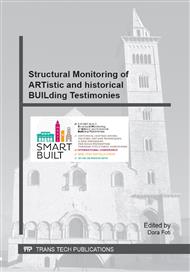[1]
R. Reitherman, Earthquakes and Engineers: An International History, American Society of Civil Engineers Press, Reston VA, (2012).
Google Scholar
[2]
S. Di Pasquale, L'arte del costruire. Tra conoscenza e scienza, Marsilio, Venezia, (2003).
Google Scholar
[2]
b] Pirro Ligorio, Libro o trattato de diversi terremoti raccolti da diversi autori per Pyrro Ligorio cittadino romano, 1570, Archivio di Stato di Torino, Codici ligoriani, vol. 28, cod. Ja. II. 15.
Google Scholar
[3]
A. Giuffrè, La meccanica dell'architettura. La statica, NIS, Roma, (1986).
Google Scholar
[4]
E. Guidoni, A. Casamento (a cura di), Le città ricostruite dopo il terremoto siciliano del 1693: tecniche e significati delle progettazioni urbane, Kappa, Roma, (1997).
Google Scholar
[5]
C.F. Giuliani, Provvedimenti antisismici nell'antichità, Journal of Ancient Topography. 21 (2011) 25-52.
Google Scholar
[6]
L.C. Lancaster, Concrete Vaulted Construction in Imperial Rome, CUP, Cambridge, 2005, 124.
Google Scholar
[7]
E. Guidoboni, G. Ferrari, D. Mariotti, A. Comastri, G. Tarabusi and G. Valensise, CFTI4Med, Catalogue of Strong Earthquakes in Italy (461 B.C. -1997) and Mediterranean Area (760 B.C. -1500), INGV-SGA, (2007).
DOI: 10.1038/s41597-019-0091-9
Google Scholar
[8]
C.M. Amici, L'uso del ferro nelle strutture romane, Materiali e Strutture. 2-3 (1997) 85-95.
Google Scholar
[9]
A. Giuffrè, Monumenti e terremoti: aspetti statici del restauro, Multigrafica, Roma, (1988).
Google Scholar
[10]
A. Ceccotti, P. Faccio, M. Nart, C. Sandhass, P. Simeone, Seismic behaviour of historic timber-frame buildings in the Italian Dolomites, In: Why Save Historic Timber Structures? Proceedings of the 15th International Symposium of the IIWC, Istanbul, Turkey, September 20th (2006).
Google Scholar
[11]
A. Bayraktar, H. Keypour, A. Naderzadeh, Application of Ancient Earthquake Resistant Method in Modern Construction Technology, XVth WCEE proceedings, Lisboa (2012).
Google Scholar
[12]
A. Naderzadeh, Application of Seismic Base Isolation Technology in Iran, Menshin. 63, 2 (2009) 40-47.
Google Scholar
[13]
A. Naderzadeh, Historical Aspects of Seismic Base Isolation Application, Proceedings of the 15th International Symposium on Seismic Response Controlled Buildings for Sustainable Society, 16-18 Sept. 2009, JSSI, Tokyo, Japan.
Google Scholar
[14]
G. Montali, L'anfiteatro di Sabratha: vecchie indagini e nuove ricerche, THIASOS rivista di archeologia e architettura antica. 1 (2012) 127-142.
Google Scholar
[15]
G. Strappa, Unità dell'organismo architettonico. Note sulla formazione e trasformazione dei caratteri degli edifici, Dedalo, Bari, (1995).
Google Scholar
[16]
A. Camiz, Storia dell'urbanistica di Ravenna nel Medioevo, In: S. Benedetti (Ed. ), Bollettino del Centro di Studi per la storia dell'architettura. Gli studi di storia dell'architettura nelle ricerche dei dottorati italiani. 42-43-44 (2009).
DOI: 10.1017/s0021853700031479
Google Scholar
[17]
C.F. Giuliani, Provvedimenti antisismici nell'antichità, Journal of Ancient Topography. 21 (2011) 25-52.
Google Scholar
[18]
Procopius, Περί Κτισμάτων, II, 8.
Google Scholar
[19]
G. Caniggia, Metodologia del recupero e studio della tipologia processuale nell'indagine e nel piano: tipologia edilizia di Venzone, In: Il recupero dei vecchi centri. Gli aspetti teorici, i modi d'intervento, Atti del convegno, 1981, Tarcento, (1983).
DOI: 10.4129/cns2008.034
Google Scholar
[20]
C. D'Amato Guerrieri, G. Strappa (Eds. ), Gianfranco Caniggia dalla lettura di Como all'interpretazione tipologica della città, M. Adda, Bari, (2002).
Google Scholar
[20]
A. Camiz, Venzone, a city rebuilt (almost) where it was and how it was,. Paesaggio Urbano. 5-6 (2012) 18-25.
Google Scholar


